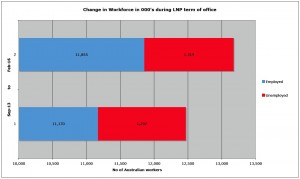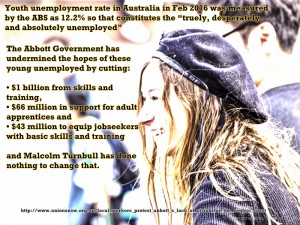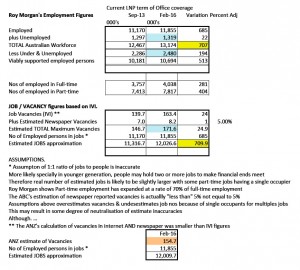The capacity for people to be cruel and disparaging, born of opinionated judgements of self-righteousness is one of the qualities at which human beings excel. Whether it’s our attitude to foreign refugees or racial discrimination among our indigenous people, if there is a “them” to our “us”, we are determinedly resistant to human unity. None is more apparent that that of the economic divide between the “haves” and the “have nots”. The social pariah (the unemployed, the disabled, the un-superannuated elderly and just poor) is the drain on society that our government would happily have removed from any significant social benefit.
—–//—–
The 2014 Budget’s proposal to eliminate six months of unemployment benefits, amongst other cuts, was the carefully considered resolution to our “economic debt crisis”. The response from the public, alternative media, professional agencies and senate surprised them. These were the unemployed, the dole bludgers, the welfare cheats, and later on, the double dippers, who were the malignant sore on the face of a civil society that needed to be lanced. So it was a mystery to the conservatives that anyone existed who wished to preserve or subsidise this lowly contingent of “un-people”, especially, when mining companies were clamouring for continued subsidies. (See Part 2 for further commentary on this.)
Punishment of Jobless
Unemployment under the coalition accelerated and coasted around 6% of the Australian workforce according to the ABS and MSM. The Liberal party claimed to be creating jobs while these bludgers were just not taking them up. These recalcitrants apparently wouldn’t attend appointments with the selfless private enterprise employment agencies who do every thing in their power to find them jobs. So Malcolm Turnbull devised an appropriate punishment for these malingering jobless. On the spot fines for failure to comply with the directions of these agencies, in relations to appointments, behaviour or training. Of course, should appeals lodged against these fines find them unjustly applied, then the job seeker will eventually be reimbursed after four months. This new disciplinary power rewards employment agencies for their “exemplary services” in spite of these “malingerers”. These are the same agencies depicted by the “Four Corners” expose “The Job Game” in February last year. The federal government presumably thought, after recovering $41M worth of false claims by these agencies following that report, that these were the most trustworthy organisations to enforce penalties on the unemployed. Perhaps, dear reader, you are beginning to suspect that there is something that is not quite kosher with the attitudes indicated above.
First off, let’s examine the veracity of the claim that 6% is our unemployment rate. Not only have the ABS stats have been rubbished by a former head of ABS who said they are “not worth the paper they are written on“, but also they have been criticised by Steve Keen a writer for Murdock’s “The Australian” paper. He doesn’t hold to the validity of the ABS statistics on “unemployment”. Steve noted that: “The ABS uses the internationally sanctioned definition of unemployment, which is similar to Tom Waits’ definition of being drunk: you have to be really, really out of it to qualify. Not only must you not be in employment, but you can’t have done even one hour of paid or unpaid in the four weeks before the survey. Nor can you be discouraged by the absence of available jobs either – you must have applied for something in the previous four weeks – and you must be available to start immediately.” The truth is, as Steve continues that the Roy Morgan’s statistics measure real unemployment in Australia – not the ABS.
If not ABS then…

So what does Roy Morgan tell us? As of Feb 2016, of the 13,174,000 people in the workforce, 1,319,000 are unemployed, and 2,480,000 Australians are unemployed or underemployed. This is 18.8% of the workforce. Participation in the workforce had risen steadily from the 12,467,000 when Abbott was elected. A reflection of numerous factors including a population growth of 1.75%, and a net migration growth of over 1%. (These add approximately 400K and 200K per year to the population respectively). Other factors include the growing propensity for later retirement. Each time the share market drops, diminished returns for superannuation funds which directly impact the capacity for those profits to fund people’s retirement capacity results in an increasing tendency to remain in the workforce beyond retirement age. Add the rising numbers of women entering the workforce. Add the single parents and the disabled; beings reassigned to “Newstart” and expected to “look” for work despite their apparent disenfranchisement. Let’s not forget, also, each year Australia has around 300K school leavers many of whom become new entrants into the workforce. Every year HSC and university graduates eventually enter the labour force via traineeships, apprenticeships, a job or the unemployment line.

Thwarting all their efforts to be employed is the pitifully small numbers of job vacancies within Australia. ANZ bank’s survey of newspaper and Internet ads for February noted a 1.2% decrease to 154,748. The Department of Employment’s Internet Vacancy Index (IVI) observed a decline of 4000 jobs to 163,000 in February. The Index does not include the declining number of newspaper ads or limited copy ads employers may put on shop windows or their websites. The ABC reported in January that “…newspaper ads rose 0.4 per cent last month, but now make up less than 5 per cent of employment advertising…”. Let’s be as generous as possible to our government in assessing the number of jobs the Australian market has – therefore ignoring ANZ Bank’s smaller estimate – and add around 5% to the government’s Vacancy Index. That makes a generous estimate of 171,000 vacancies available to 1.3 Million unemployed (or nearly 2.48M if you add the underemployed). The opinion of the Employment Minister Michaelia Cash is that there are jobs for Australians to find?
Beyond Numbers

Numbers, of course, never tell the whole story as one need also consider issues such as locality & accessibility limitations, skill & education levels, competition, financial limits, literacy, and the arbitrary selection processes and criteria of employers. Let me give you an example of locality issues. NSW and Victoria supply 64% of all Australian job vacancies. You certainly don’t want to be looking for employment in Tasmania; the Northern Territory, ACT or South Australia whose combined percentage of vacancies do not exceed 9% for the Australian market. Skills and education levels in Australia are eroded by the fall off of trade apprenticeships, and the growing expenses inherent in TAFE qualifications and university costs. Need I expand further with all the rest?
Other factors for which I have not made adjustments, are the issues around foreign workers with rights to work in Australia. In May of 2015, the SHM reported that there were 167,000 457 visa workers and, that the 1.2 million foreigners who have work rights include 160,000 with working holiday visas or more than 623,000 New Zealand special visa holders. Now to be fair to the government, the number of 457 visa holders has recently dropped to just over 100K, although that is officially only the number of direct visa holders and does not include accompanying families. It is not that all these foreigners are competing for the jobs available to Australians but that they can, and of course, many do. Companies claim to bring in foreigners on 457 Visas because of the absence of appropriate skills in this country. What does that, therefore, say about the level of education we provide or our commitment to education? (more in part 2)
Non-Australian participants
Even for the ABS stats, for what ought to be reclassified as the “absolutely, desperately, undeniably unemployed”, there are five people for every vacancy. For the more realistic Roy Morgan numbers of merely unemployed, there is an 8:1 ratio. Add in the underemployed, and the ration becomes 14:1. Add in the 1.2M foreigners with work rights and your competition for work becomes a ratio of 21:1. Given the requirement for the 1.3M to write 20 applications a month to – to at the most – 171Kvacancies, statistically, the average employer might receive 154 letters a month. These numbers, would, of course, vary due to local accessibility, skill/education required, etc. and be dependant on a given vacancies attractiveness to foreign workers, including 457 visa workers, or underemployed and employed “drifters” (fully employed people who would like to change jobs).
Poverty
Should the unemployed suffer difficulties inherent in limited access to appropriate finance, transport, training, education, online facilities, social connectivity, digital literacy, access to health services, housing, clothing, live in the wrong State or city and have to busy “working” for the dole or be occupied be irrelevant training and paperwork from your employment agent; then they can kiss any job prospects goodbye! Worth noting is that unemployment “wages” are $391 below the international poverty line. On top of that, the mainstream media goes out of their way to find someone, anyone in fact, who looks as though he/she is not actively searching for work, and labels them as “dole bludgers” on the front page of a Murdock press paper or a current affairs program. This effectively extends that label – with no justification – to nearly a fifth of Australia’s workforce. That 18.8% of the workforce constitutes a workforce that probably lives below or close to the poverty line, which has some correlation to ACOSS’s claim that over 2.5M Australians live in poverty. Following an attack by the media, or being treated disparagingly and/or having been fined by the very people who are supposed to assisting them find jobs – that actually are statistically irrelevant – and having to “work for the dole” to receive a “pay rate” far below minimum wages, what would you believe is their level of psychological resilience?
Telling someone “get a job” as though it was simple, expresses an opinion (a dismissal of reality in actuality). It reflects ignorance of the real facts evident in the real factually non-opinionated numbers of jobs available and the vastly larger numbers of people competing for them and the real (not imagined or opinionated) sociological issues associated with being unemployed.
Job creation?
So are the Liberal party policies facilitating jobs creation in Australia? Alan Austin questioned the media and Coalition’s take on unemployment in February referencing Scott Morrison’s claim that Australia had generated more than 300,000 jobs since the coalition was elected. Alan focused on ABS figures pointing out numerous flaws in the coalitions numbers. What, though, are the numbers from Roy Morgan’s perspective? It would appear 300K jobs generated, grows to 685K jobs since September 2013. Looking so much better than you would have to wonder why the Government only uses ABS’s figures until you look at the larger realistic unemployment numbers.

Workforce Numbers, jobs and Vacancies
It is, however, the Department of Employment’s vacancy index that has shown relatively slow marginal growth in job vacancies of only 23.6K over the full LNP term of office. [IVI Sept 2013 vacancies: 139K and Feb 2016: 163K] Keep in mind that NET unemployment only (RM figures), has increased by 22K and net participation has grown by 707K during the coalition occupation. [Roy Morgan Sept 2013 unemployed: 1297K to Feb 2016: 1319K and RM Sept workforce: 12467K to Feb 2016: 13174K]. With such a small rise in vacancies, it becomes concerning that no matter which statistics, either ABS’s or Roy Morgans job growth are used, it is evident that it is only just keeping ahead of the increase in workforce participation. The net change of growth of employment (vacancies plus occupied jobs) 709.9K with the total workforce change 707K (highlighted in yellow in the spreadsheet) suggest the market is only just keeping its head above the rising water of workforce population growth by 2,900 jobs in three years. Statistics – is a game that has margins of error – if you were to use ANZ’s vacancy numbers, then we would be drowning by 14,000 jobs. Either way, you look at it, if Australia fails to maintain a better margin in the growth of jobs, then the workforce participation growth would overtake jobs; and unemployment will skyrocket. As a country, we had better hope there are no significant job losses on the horizon like, oh … a major loss of manufacturing jobs for example. At best, this country is just “treading water” in a desperate “dog paddle” to stay afloat, and at worst, they are peering over a chasm into a very deep valley and an economy about to collapse into recession.